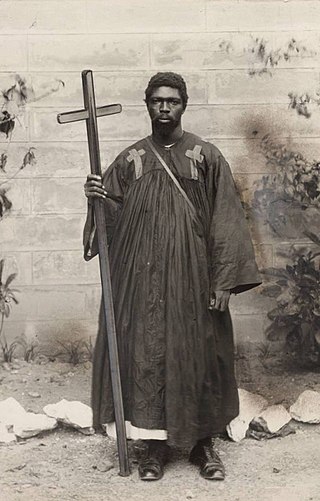Related Research Articles
The Ashanti–Fante War (1806–1807) was a war fought between the Ashanti Empire and the Fante Confederacy in the region of what is currently the Republic of Ghana.

The modern Mfantsefo or Fante confederacy is a combination of Akan people and aboriginal Guan people. The Fante people are mainly located in the Central and Western regions of Ghana, occupying the forest and coastal areas. Their land stretches from the eastern part of western region in the west to Gomoa in the east. The Fante can be broadly categorized into two groups - the Borbor/Boka Fante(Akan ancestry) and the Etsii Fante(Guan ancestry). Over the last half century, Fante communities have been established as far as Gambia, Liberia, and even Angola due to fishing expeditions. Major Fante cities and towns in modern Ghana include Cape Coast, Saltpond, Elmina, Sekondi-Takoradi, Agona Swedru, Mankessim,Winneba,Shama,Apam, Komenda, Kasoa and Anomabo.

The Fante Confederacy commonly refers to the modern Confederation formed in 1868, but can also refer to its predecessor, the Mankessim Kingdom. The modern Confederation is seen as one of the first and most prominent self-rule movements in Ghana and the entirety of Africa. Its mission was to shake off colonialism and establish a modern free democratic state.
Osei Bonsu also known as Osei Tutu Kwame was the Asantehene. He reigned either from 1800 to 1824 or from 1804 to 1824. During his reign as the king, the Ashanti fought the Fante confederation and ended up dominating Gold Coast trade. In Akan, Bonsu means whale, and is symbolic of his achievement of extending the Ashanti Empire to the coast. He died in Kumasi, and was succeeded by Osei Yaw Akoto.
The Akan people are a Kwa group living primarily in present-day Ghana and in parts of Ivory Coast and Togo in West Africa. The Akan speak languages within the Central Tano branch of the Potou–Tano subfamily of the Niger–Congo family. Subgroups of the Akan people include: the Agona, Akuapem, Akwamu, Akyem, Anyi, Ashanti, Baoulé, Bono, Chakosi, Fante, Kwahu, Sefwi, Wassa, Ahanta, Denkyira and Nzema, among others. The Akan subgroups all have cultural attributes in common; most notably the tracing of royal matrilineal descent in the inheritance of property, and for succession to high political office. All Akans are considered royals in status, but not all are in royal succession or hold titles.
The Efutu are a part of the Guang people who are historically known to be the aboriginal inhabitants of present-day Ghana. They founded the coastal area about 1390 C.E. The Efutu are found in Awutu, Adina, Senya-Beraku and Winneba and their main occupation is fishing. Their mighty Guan culture have had influence on neighbouring Akan cultures.Akans,especially the borbor Mfantsefo had adopted their names and some cultural elements and fused it with theirs through integration to produce modern cultures which is shared by both the Guan people of Winneba and their Akan neighbours.However,Efutu just like other Guans states have a patrilineal system of succession. The Simpa Kingdom was formed about 1400 AD.

Denkyira or Denkyera was a powerful nation of Akan people that existed before the 1620s, in what is now modern-day Ghana. Like all Akans, they originated from Bono state. Before 1620, Denkyira was called Agona. The ruler of the Denkyira was called Denkyirahene and the capital was Jukwaa. The first Denkyirahene was Mumunumfi.
Articles related to Ghana include:

The Akyem are an Akan people. The term Akyem is used to describe a group of four states: Asante Akyem, Akyem Abuakwa, Akyem Kotoku, and Akyem Bosome. These nations are located primarily in the eastern region in south Ghana. The term is also used to describe the general area where the Akyem ethnic group clusters. The Akyem ethnic group make up between 3-4 percent of Ghana's population depending on how one defines the group and are very prominent in all aspects of Ghanaian life. The Akyem are a matrilineal people. The history of this ethnic group is that of brave warriors who managed to create a thriving often influential and relatively independent state within modern-day Ghana. When one talks of Ghanaian history, there is often mention of The Big Six. These were six individuals who played a big role in the independence of Ghana. Of the big six, people of Akyem descent made up the majority.

The Asante Empire, also known as the Ashanti Empire, was an Akan state that lasted from 1701 to 1901, in what is now modern-day Ghana. It expanded from the Ashanti Region to include most of Ghana and also parts of Ivory Coast and Togo. Due to the empire's military prowess, wealth, architecture, sophisticated hierarchy and culture, the Asante Empire has been extensively studied and has more historic records written by European, primarily British, authors than any other indigenous culture of sub-Saharan Africa.

Mankessim is a town in the Central Region of Ghana, West Africa. It is approximately 75 km west of Accra, on the main road to Sekondi-Takoradi. It is the traditional headquarters of the Fante ethnic group of Ghana. Mankessim's history is linked to three famed warriors: Obrumankoma, Odapagyan and Oson, who helped the Fante people migrate from Techiman in the current Bono Region to Adoagyir in the Central Region. The town is located at an elevation of 75 meters above sea level and its population according to the 2010 Census was 38,313.

The Asante, also known as Ashanti in English, are part of the Akan ethnic group and are native to the Ashanti Region of modern-day Ghana. Asantes are the last group to emerge out of the various Akan civilisations. Twi is spoken by over nine million Asante people as their native language.
Akuapem, also known as Akuapim, Akwapem Twi, and Akwapi, is one of the literary dialects of the Akan language, along with Asante and Fante, with which it is mutually intelligible. There are 626,000 speakers of Akuapem, mainly concentrated in Ghana and southeastern Cote D'Ivoire. It is the historical literary and prestige dialect of Akan, having been chosen as the basis of the Akan translation of the Bible.

An Akrafena is an Akan sword, originally meant for warfare but also forming part of Akan heraldry. The foremost example of an akrafena is the Mponponsuo, which belonged to Opoku Ware II. It has survived to the present day because it is still occasionally used in ceremonies, such as the Akwasidae Festival.

Samson Kwame Oppong also Sampson Opon or Opong was a controversial Akan Christian preacher-prophet on the Gold Coast in the 1920s. His missionary zeal, unconventional and fiery ministry helped entrench Methodism in the Ashanti and Brong-Ahafo Regions of Ghana, through a large-scale spiritual awakening and revival. Though his knowledge of Christian theology was minimal, he is known to have employed threats and other coercive techniques to proselytise in the Ghanaian towns and villages he worked in.
The Asafo flags are regimental flags of the Fante people, an ethnic group that mainly resides in Ghana's central coastal region. The flags are influenced by a combination of Akan proverbs, visual imagery, and European heraldic tradition.

The military of the Asante Empire first came into formation around the 17th century AD in response to subjugation by the Denkyira Kingdom. It served as the main armed forces of the empire until it was dissolved when the Asante became a British crown colony in 1901. In 1701, King Osei Kofi Tutu I won Asante independence from Denkyira at the Battle of Feyiase and carried out an expansionist policy.

Ghana–United Kingdom relations are the diplomatic, historical and trade relations between Ghana and the United Kingdom. Modern state Ghana-UK relations began when Ghana became independent from the UK in 1957 as the Dominion of Ghana.

The documented history of Elmina begins in 1482 with an agreement between the Portuguese navigator Diogo de Azambuja and the ruler of Elmina, called Caramansa by the Portuguese. In it, the Portuguese were allowed to build the first European fortress in sub-Saharan Africa. For the next 150 years until the conquest by the Dutch in 1637, Elmina was the capital of the Portuguese bases on the Gold Coast, then for about 250 years the capital of the Dutch Empire in West Africa. Since the capture of the lease for the two fortresses of Elmina by the Ashanti in 1701, the city was also important to the Ashanti Empire. Until the 19th century, Elmina was one of the most populous cities in the Gold Coast, surpassing Accra and Kumasi. The trade in gold, slaves and palm oil brought the city into direct contact with Europe, North America, Brazil and, through the recruitment of soldiers, also with Southeast Asia. It was not until the takeover and destruction of the city by the British in 1873 that Elmina lost its prominent position in the Gold Coast.

Kwadwo Egyir, later renamed Brempong Kojo and later Europeanized as Caboceer Cudjo, was born around 1700 in Ekumfi in a Fante chiefdom on the Gold Coast, the village being located in what is now the Ekumfi district of Ghana, and died on March 24, 1779, in Cape Coast. He was a slave trader in the service of the British Gold Coast in Cape Coast.
References
- 1 2 3 Shumway, Rebecca (2011). The Fante and the Transatlantic Slave Trade. Rochester Studies in African History and the Diaspora. Vol. 52. Boydell & Brewer. ISBN 978-1-58046-391-1. JSTOR 10.7722/j.ctt1x72ng.
- ↑ Shillington, Kevin (2005). "Akan States: Bono, Dankyira, Wassa, Akyem, Akwamu, Fante, Fifteenth to Seventeenth Centuries". Encyclopedia of African History 3-Volume Set. Routledge. ISBN 978-1-135-45670-2.
- ↑ "Fante confederacy | African history [late 17th century-1824] | Britannica". www.britannica.com. Retrieved 2022-05-12.
- ↑ Laumann, Dennis Heinz (1993). "'Compradores-in-Arms': The Fante Confederation Project (1868-1872)". Ufahamu: A Journal of African Studies. 21 (1–2): 120–136. doi: 10.5070/F7211-2016747 .
- ↑ Danquah, J.B. (1928). Gold Coast: Akan Laws and Customs and the Akim Abuakwa Constitution. George Routledge & Sons – via University of Ghana Digital Collections UGSpace.
- ↑ Law, Robin (March 2013). "The Government of Fante in the Seventeenth Century". The Journal of African History. 54 (1): 31–51. doi:10.1017/S0021853713000054. S2CID 158660952. ProQuest 1400708713.
- ↑ Gocking, Roger (2005). The History of Ghana. Westport, Connecticut: Greenwood Press. p. 30. ISBN 0-313-31894-8.
- ↑ V. Tarikhu, Farrar (2020). Precolonial African Material Culture: Combatting Stereotypes of Technological Backwardness. Rowman & Littlefield. p. 243. ISBN 9781793606433.